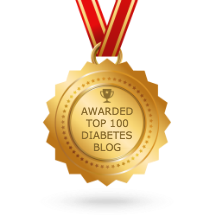I considered titling this “Anna Floreen Was Diabetes-Free for 5 Days,” because she was and now she’s not. And I’m curious what that transition has been like — picking up your chronic illness again after you dropped it from your shoulders and walked off into the sunshine, so to speak.
April 4, 5, 6, 7 and 8, days I’m sure Anna Floreen will never forget, she was effectively “cured” of her Type 1 diabetes (T1D). Anna participated in the Massachusetts General Hospital Beacon-Hill study.
She was among approximately 30 T1D patients testing the performance of the “bionic pancreas” outside the hospital. She was, however, hooked up to an IV monitor overnight, restricted to a three-mile radius and had a nurse by her side at all times.
Anna Floreen wearing the bionic pancreas Anna’s had T1D for 24 years, since she was 6 years old. Yet that early week in April, she didn’t. She didn’t have to figure out how many carbohydrates were in every morsel of food she ate and how much insulin she needed to take to cover it.
She didn’t have to guess if her workout at the gym or her walk to work would cause her blood sugar to go too low, and then wonder whether or not to go or prepare for possible low blood sugar.

She didn’t have to guess if her workout at the gym or her walk to work would cause her blood sugar to go too low, and then wonder whether or not to go or prepare for possible low blood sugar.
She didn’t have to poke her finger 10 times a day to see her blood sugar number. That’s 50 pricks she didn’t have to feel. Or worry as she fell asleep that she might get a severe low blood sugar during the night and not wake up.
That is what makes T1D so relentless and dangerous. Throughout the day, every day, one has to think and act like a normal functioning pancreas, the organ that controls blood sugar. That is also what makes this study exciting and hopeful.
The Bionic Pancreas
The bionic pancreas consists of three pieces of hardware. There’s an iPhone with an app that contains the system’s control software and algorithm and a continuous glucose monitor (CGM).
The bionic pancreas consists of three pieces of hardware. There’s an iPhone with an app that contains the system’s control software and algorithm and a continuous glucose monitor (CGM).
The CGM’s sensor/transmitter, worn under the skin, streams glucose (blood sugar) data to two connected infusion pumps. One delivers insulin to lower blood sugar and one delivers glucagon to raise it. Based on glucose levels transmitted every five minutes from the CGM, the app determines and dispatches how much insulin or glucagon should be delivered to maintain ideal blood sugar levels.
If Anna’s blood sugar began to veer toward hypoglycemia (blood sugar below 70 mg/dl (3.8 mmol/l) — the dreaded side effect of insulin that can cause coma and even death — the pump containing glucagon released some to raise Anna’s blood sugar. If Anna’s blood sugar began rising too high, the insulin pump sent a precise amount of insulin into Anna’s blood stream to curb the rise and bring it back down into the normal range between 80 mg/dl (4.4 mmol/l) and 120 mg/dl (6.6 mmol/l).
The bionic pancreas and its algorithm are the genius of biomedical engineer Edward Damiano. Damiano is also the father of David, who got Type 1 diabetes at 11 months. That’s when he began working on an automated “closed loop” system that would regulate blood sugar and relieve patients of the daily decisions and actions they must now perform.
The bionic pancreas and its algorithm are the genius of biomedical engineer Edward Damiano. Damiano is also the father of David, who got Type 1 diabetes at 11 months. That’s when he began working on an automated “closed loop” system that would regulate blood sugar and relieve patients of the daily decisions and actions they must now perform.
Anna’s Experience
Anna blogged each of the five days she wore the bionic pancreas sharing her experience with the thousands of visitors to the Type 1 diabetes online community, Glu. Anna works as Glu’s Community Outreach Manager, and I recommend you read her posts. You will see how far technology has taken us.
Anna blogged each of the five days she wore the bionic pancreas sharing her experience with the thousands of visitors to the Type 1 diabetes online community, Glu. Anna works as Glu’s Community Outreach Manager, and I recommend you read her posts. You will see how far technology has taken us.
I interviewed Anna five days after her trial participation wanting to know a bit more about the emotions she’d expressed, and also what it is like to suddenly be disease-free and then ill again.
Anna wrote in her first post, “The best part so far has been the lack of worry, emotional guilt, and shame that accompany all of us too often when it comes to decision-making between me and my ‘external organ’ pump that I’ve had a solid relationship with for over a decade.”
Anna told me over the phone, “The 24/7 of diabetes eats away at your mental aptitude and spirit. I would wear 10 sites on my body if it meant I didn’t have to deal with the constant thinking, and the embarrassment, shame and guilt that accompanies diabetes each day. I stare at my CGM and base my self-worth on a trending number graph! How crappy is that, and people don’t get it.”
“During the trial I felt so free. My brain was free of decision-making and dreading the consequences of my decisions. No more thinking should I have taken the subway instead of walking to prevent that low? Should I not have had that extra chocolate kiss at the holiday party? The lack of worry was amazing.”
What most people don’t know about T1D is the emotional stress of all day trying to keep your blood sugar within a narrow, prescribed, acceptable band. Anna tells people it’s like stepping on a scale 24 hours a day. The moment before you do, you feel the shame and guilt of maybe discovering you gained weight. She said many people with Type 1 diabetes feel that 24 hours a day.
As for what it’s like to lay down your disease and pick it up again ,Anna indeed went through bionic pancreas withdrawal.
“For days I was angry at diabetes again,” Anna said. “I thought I would be much more motivated to take care of my diabetes, knowing the potential for it to be in phenomenal control. But it was like I was diagnosed all over again. I didn’t want to do anything.”
“During the trial everything was done for me,” said Anna. “So much so even the nurse asked me, ‘Do you want to prick your finger or do you want me to do it for you?’ You do it, I said. Imagine having someone prick your finger being a treat!”
The outpouring of support from the online diabetes community, having so many families and friends thank Anna for what she did and knowing she’s provided important data from the trial motivated Anna to take care of her diabetes again.
She’s also inspired by having experienced something she never thought she would, the day she didn’t have to worry about her diabetes. She hopes the trial inspires others to trust that research and technology are bringing us closer to a cure.
The outpouring of support from the online diabetes community, having so many families and friends thank Anna for what she did and knowing she’s provided important data from the trial motivated Anna to take care of her diabetes again.
She’s also inspired by having experienced something she never thought she would, the day she didn’t have to worry about her diabetes. She hopes the trial inspires others to trust that research and technology are bringing us closer to a cure.
Defining the Cure
One of the last things Anna shared both surprised and didn’t surprise me. “I feel like I’ll always have diabetes even if there is a cure,” Anna said. “Just like during the first meal of the trial when I reached down to grab my pump and then realized it wasn’t there. Diabetes has been my life. My mindset, that diabetes perspective whatever it is, will never go away. Even if there is a cure, I don’t think I will ever feel mentally cured.”
One of the last things Anna shared both surprised and didn’t surprise me. “I feel like I’ll always have diabetes even if there is a cure,” Anna said. “Just like during the first meal of the trial when I reached down to grab my pump and then realized it wasn’t there. Diabetes has been my life. My mindset, that diabetes perspective whatever it is, will never go away. Even if there is a cure, I don’t think I will ever feel mentally cured.”
Having lived with T1D for 41 years I feel the same. I also feel the same as Anna that I’ll be happy to give up the rest. The constant carbohydrate and insulin calculations, the running tape of what’s my blood sugar now, and questioning is it safe to simply go take a walk?
It’s a brave thing Anna did. That everyone who participates in a clinical trial does. Not just risking that the device you’re testing may fail, but that it will succeed. That you will know freedom and then have to give it back.
Would you give up your diabetes, cancer, AIDS, Parkinson’s, rheumatoid arthritis only to have it back again after being free?
Damiano’s hope is that the bionic pancreas will be perfected and available by 2017, the year his son will be entering college. I’m sure there are about 3 million people who are now hoping right along with him.
Next Steps
Extensive testing of the bionic pancreas’ software-controlled system has already been done on diabetic pigs and in three successful in-hospital studies of adults and adolescents over the past 4.5 years.
Extensive testing of the bionic pancreas’ software-controlled system has already been done on diabetic pigs and in three successful in-hospital studies of adults and adolescents over the past 4.5 years.
The Food and Drug Administration has given Damiano and his research associates the green light to carry out the first of three longer-duration outpatient studies over the next 18 months. Participants will have less nursing supervision and greater freedom of movement.




